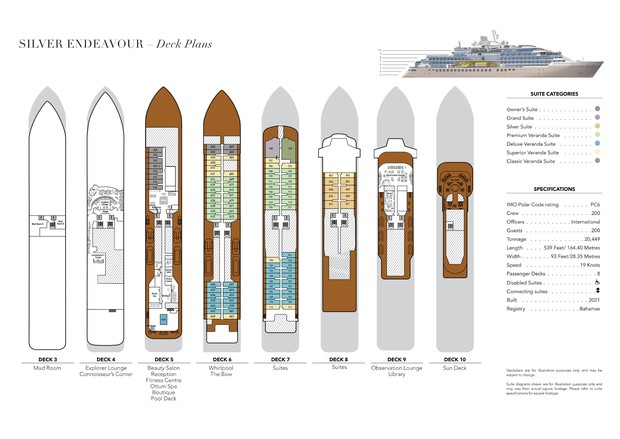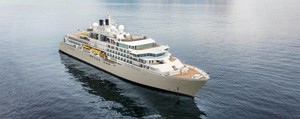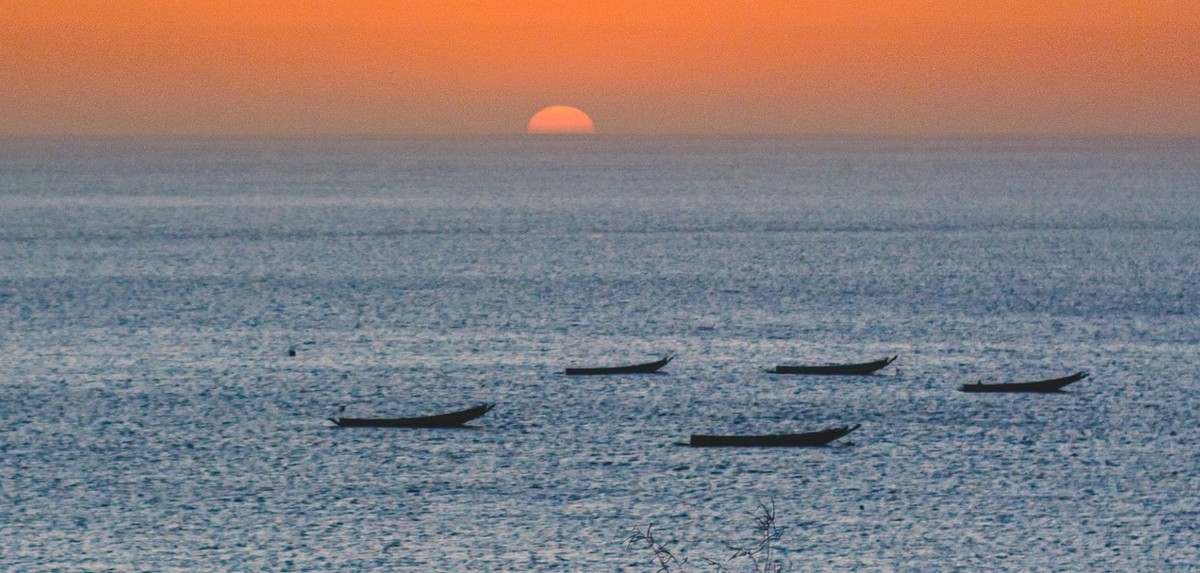
An extraordinary trans-oceanic journey linking South America and West Africa. Explore Argentina, Uruguay, and Brazil’s remarkable cities, beaches, and remote islands — from Rio de Janeiro’s iconic shores to the coral reefs of the Abrolhos Archipelago. Cross the Atlantic to Sierra Leone, then explore the 88 islands and ancient traditions of the remarkable Bijagós Archipelago, where hippos wade through coastal waters and turtles nest on untouched beaches.
- Traverse two continents in one voyage, combining South America’s vibrant coast with West Africa’s remote archipelagos.
- Experience Brazil’s spectrum of landscapes — from Rio’s iconic skyline to the reefs and wildlife of the Abrolhos and Porto Seguro regions.
- Explore the untouched Bijagós Archipelago, encountering rare wildlife and traditional island cultures rarely accessible to travellers.
Availability is always subject to confirmation. Please check with us before booking flights
Prices quoted here are often dependent on currency fluctuations. Please check with (01432 507450 or info@small-cruise-ships.com) for the very latest price, which may well be cheaper than the one advertised here.
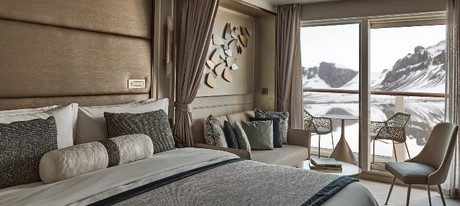

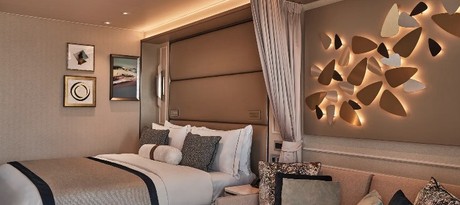
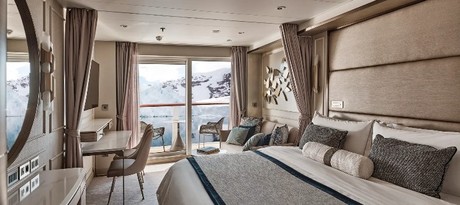
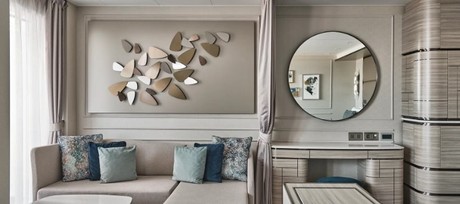
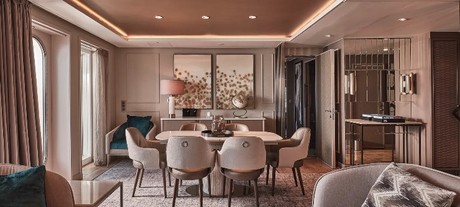

Passionate, and alive with an infectious crackling energy, the Argentine capital is a breathlessly romantic city, which blends old-world colonial architecture with a down-to-earth Latin American clamor. Famed for steamy tango interplays, and expertly seared steak slabs, a visit to Buenos Aires is a fiery fiesta for the senses. Parque Tres de Febrero is a 400-hectare oasis where 18,000 rose bushes bloom, and skyscrapers give way to still lakes and pretty paths of rollerblading locals. Mighty palm trees - that look like exploding fireworks - stand tall in Plaza de Mayo, the heart of this sprawling cosmopolitan capital of 48 barrios. The square has served as the stage for many fundamental events in this country’s history, and the location where the seeds of independence were sewn continues to serve as the city’s gathering point - and is a place for solidarity, rebellion, and revolution. The presidential Casa Rosada’s salmon-hued Palatial Palace borders the plaza, while nearby Museum Nacional de Bellas Artes houses the biggest collection of public art in Latin America. Teatro Colón, the opulent 1908 opera house, is one of the world’s finest venues - musical performance here take on an ethereal quality, with the exceptional acoustics transferring every quiver of bow, and tremor of vocal cord, to the audience in spine-tingling clarity. The gargantuan, precipitous terraces of Bombonera Stadium form another of Buenos Aires’s incredible venues, and a wall of noise emanates from it when Boca Juniors take to the field. Juicy steak and punchy Malbec flow in the city’s parrillas – steakhouses - while glitzy bars and thumping nightclubs welcome revelers late into the night. It’s not just the meat that sizzles here either - tango dancers fill milongas - dance halls - to strut passionately until the early hours. Sip steaming mate, the country’s national drink, shop in covered markets, and explore Cementerio de la Recoleta - a city of grand graves and intricate memorials honoring presidents, politicians, and notable Argentine heroes from history.
Poetic, worldly, and jam-packed with historical intrigue, Uruguay’s refined capital is a city of culture, creativity, and beachfront bliss. Just shy of half of all of Uruguay’s population calls Montevideo home, and the city is enjoying a resurgence, as its reputation as one of South America’s essential destinations burgeons. Glorious colonial architecture has been repurposed to house cultural treasures - while glassy skyscrapers, modernist museums, and twisted artworks spring up regularly across this vibrant, energetic city, which stands across the Río de la Plata from Buenos Aires. Recognized as a UNESCO Creative City, there’s rich intellectual history here, not to mention sultry tango - a dance form that the Uruguayans claim as their own. With bright and breezy tree-lined streets, and refreshing salty sea breezes cooling its endless beaches, Montevideo is an incredibly livable seaside city. La Rambla, the long and wide waterfront path, provides a welcome partition from the city’s buildings and is a wonderful place to wander and relax on benches and sea walls. Having toed and froed between Portuguese and Spanish rule at the height of their colonial powers, the city and country are littered with fortifications and historical relics. Head to the central square Plaza Independencia to see the statue and mausoleum dedicated to José Artigas, who is known as the father of Uruguayan independence, which was achieved in 1825. You’ll also be standing before an iconic Montevideo landmark, the beautiful Palacio Salvo’s impressive tower. Mercado del Puerto is a taste of Uruguayan cuisine, blending mouth-watering influences from Brazil and Argentina – try juicy, fire-seared steaks, and tasty caipirinhas cocktails.
The fingertips of a showstopping sculpture, emerging from Punta Del Este's golden sands, is the perfect example of this chic beach city's creative outlook. Stunning stretches of shining sands line the peninsula's coast, attracting the great and glamourous from across Uruguay and Argentina. Drawn to the beautiful beaches of this seaside city, the well-heeled visitors are joined by a flotilla of yachts, which park up for summer in the "Monaco of the South" - the continent's city to see and be seen. One of Punda del Este's main beaches, Playa Mansa, enjoys calm seas and a sun-soaked location - overlooked by a soaring lighthouse, which is orbited by gliding sea birds. The sand is soft and inviting, so lie back to soak up the intense sun, before views of Gorriti Island just offshore. On the other side is Playa Brava, where the city's signature artwork, "The Hand" - one of many quirky sculptures that litter the streets - grasps at the sky. Relax your way - whether that's cracking golf balls along coastal courses, cycling beside washing waves, or swimming in tempting waters. Bustling nightlife, art galleries, and museums give Punta del Este an artsy, eclectic atmosphere. Close to the port, you can discover fancy restaurants, serving up stacks of fresh seafood - and enjoy opulent meals while relishing golden views down over the port, where lavish yachts and modest fishing boats mingle. Head down to the harbor to see fishermen selling freshly caught produce and sea lions gathering to feast on the scraps.
Days at sea are the perfect opportunity to relax, unwind, and catch up with what you've been meaning to do. So whether that is going to the gym, visiting the spa, whale-watching, catching up on your reading, or simply topping up your tan, these blue sea days are the perfect balance to busy days spent exploring shoreside.
Atlantic rainforest draws us inland from the Paranaguá port, and it is fun exploring it by boat, coach, foot, or even up a tower! Much of the rich and diverse forests of Brazil’s Atlantic coast have been cleared but here the largest surviving tracts are preserved in national parks and reserves. The uniqueness and rarity of the forest’s biology led to the declaration of the Atlantic Forests of Southeastern Brazil World Heritage Area. Dramatic rainforest-covered mountains have scenic wonders with names like Devil’s Throat Canyon and Véu da Noiva Waterfall, describing the ruggedness of the landscape. One way to experience the Atlantic forest is by boating along waterways amongst the trees. Local people still live with the forest and they help us understand their traditional links with the flora and fauna. Birds are a feature of the Atlantic forests with many species not found elsewhere. Private reserves with a focus on environmental education and leisure help visitors appreciate the forest. Walking trails, guides and a viewing tower help us to spot and identify the diverse avifauna and exuberant flora. It is hard to decide whether to try to photograph a hummingbird hovering at a flower or concentrate on the flower, because it doesn’t move. Within the forests of the coastal range are historic towns like Guaraqueçaba and Morretes. Here, we meet the colorful Brazilian culture. Colonial architecture, friendly people, and a little relaxation with good local food are added to the day’s mix of experiences.
Surrounded by dense swathes of rainforest, the gorgeous 18th century architecture of Paraty sits in a spectacular location on Brazil’s verdant Costa Verde. The pedestrianised town is a whitewashed canvas, splashed with bold blocks of primary colours, which shine above cobbled streets. Paraty and four nearby protected natural areas of Brazilian Atlantic Forest are a UNESCO World Heritage Site for their cultural and natural values. Gold is a key theme for Paraty and the region. Gold was stripped from inland mines and brought to Paraty’s port for export. Mules trains transporting the wealth reprovisioned at the 17th century Bananal Farm, with its water driven sugar mill, located 8 kilometres (5 miles) from Paraty. Gold is irresistible. English and French pirates hiding out in the nearby village of Trinidade raided the gold ships leaving Paraty. Now the modern gold is the colour of the beaches, where rainforest cascades from the hills. There are many ways to experience Serra da Bocaina National Park, whether by foot, hoof or paddle. The sounds of birds in the rainforest will accompany you as you traverse trails to gushing streams or cross the sheltered waters of Paraty Bay to tropical islands. Birds are prolific around Paraty. The Atlantic forest has 120 endemic (not found elsewhere) species of birds in addition to more widespread types. Brilliantly coloured tanagers are highlights, as are hummingbirds, toucans and parrots. When asked ‘what is your favourite bird’? Answer with ‘the next one’.
Lie back on the golden sands to soak up the extraordinary setting - or watch on as muscled Cariocas - locals - perform effortless athletic feats, during casual volleyball matches. A trip up to Rio de Janeiro's iconic art-deco statue of Christ the Redeemer is, of course, a must do - offering an extraordinary view of the city rolling out before your eyes. You'll also want to take a cable car to swing by the top of Sugarloaf Mountain, which juts sharply into the sky from nowhere. Brazil's second-biggest city moves to an infectious samba beat, and the famous thumping Carnival floods color and floats down its streets each year. Of course, Rio is also a city of sharp cultural contrasts - offering fun in the sun for some, while life goes on very much as it always has for others. Take a guided tour, led by a resident, to see the conditions inside these complex tapestries of color and chaos first-hand. Tijuca National Park, offers easy-to-access tranquility, immersing you in dense forestry and whopping birdsong. Later, watch the fiery shades of sunset spread across the sky in the city's oh-so-famous evening light show. With so much to offer, you'll quickly learn how Rio earned its other name "Cidade Maravilhosa" - The Marvellous City.
Days at sea are the perfect opportunity to relax, unwind, and catch up with what you've been meaning to do. So whether that is going to the gym, visiting the spa, whale-watching, catching up on your reading, or simply topping up your tan, these blue sea days are the perfect balance to busy days spent exploring shoreside.
Just 70 km east of Nova Viçosa, Bahia are the five islands forming the Abrolhos Archipelago. These islands are part of two reef systems which run parallel to the coast and cover an area of some 6,000 km² -Brazil’s most extensive reef system. Two parts of the reef system including the archipelago have been declared a marine park (Parque Nacional Marinho dos Abrolhos) covering 913 km². A lighthouse and small Brazilian Naval station are on Santa Barbara, but of the five islands only Siriba, one of the two westernmost islands, can be visited. A track runs for some 1,600 meters around the island, permitting to see the fauna, flora and geology. The Abrolhos Archipelago is the Southwest Atlantic’s largest reproduction area for humpback whales which tend to be there between July and November. Loggerhead and green sea turtles will start to come in November to lay their eggs on the few sandy beaches, and hawksbill turtles have also been seen. Masked and Brown Boobies, Magnificent Frigatebirds, Red-billed Tropicbirds, Sooty Terns and Brown Noddies have all been recorded as nesting on the islands.
Porto Seguro – loosely translated as safe bay – is known as “Brazil’s birth certificate”. The port was the first place that Alavares Cabral and his crew set foot on while on their way to India in 1500. This makes the town the oldest in the country at 500 years. With three churches and around 40 buildings (both private residential houses and public institutions), restored by the state government for the 500th anniversary celebration of Brazilian discovery, Porto Seguro wears its age well.
Days at sea are the perfect opportunity to relax, unwind, and catch up with what you've been meaning to do. So whether that is going to the gym, visiting the spa, whale-watching, catching up on your reading, or simply topping up your tan, these blue sea days are the perfect balance to busy days spent exploring shoreside.
Local Brazilians flock to the sweeping beaches at Natal. As the capital of Rio Grande do Norte state, Natal has developed quickly to cater for this style of tourism. However, it has history. In 1598 the Portuguese constructed Fortaleza dos Reis Magos. The fort’s strategic location is at the mouth of the Rio Potengi, and near the easternmost and thus closest point of South America to Europe and Africa. Beyond the modern tourism strip is an older Natal with the governor’s palace, mayor's office and André Albuquerque Square. American architectural influences persist from the time the city was a base during World War II. The city encircles a natural park of urban forest and sand dunes. The 16th century Portuguese Fort Reis Magos contains details of battles among the Portuguese, Dutch, and French. The craft centre demonstrates lace tatting and Capoeira, the Afro-Brazilian martial art developed by slaves in the 16th century. Capoeira combines dance, acrobatics and music, and often involves hands on the ground and inverted kicks. Try it on land, not the ship. Dramatic windswept bare sand dunes lie in and around Natal. The dunes at Genipabú are ever changing as the winds alter direction and speed. Dunes transform and are never in the same place for long. Amongst the dunes are clear lakes and pockets of flora. Dune buggies allow you to explore the dunes in either a ‘unemotional’ sedate style or an ‘emotional’ (read, scary adrenaline rush) style. Pitangui Lagoon allows the survivors to swim or calm down.
Days at sea are the perfect opportunity to relax, unwind, and catch up with what you've been meaning to do. So whether that is going to the gym, visiting the spa, whale-watching, catching up on your reading, or simply topping up your tan, these blue sea days are the perfect balance to busy days spent exploring shoreside.
Standing on the rocks of Sierra Leone’s Western Peninsular, the rusting, photogenic Aberdeen Lighthouse welcomes sea-faring visitors ashore. Aberdeen juts out into the Atlantic waves to the north of Sierra Leone’s sprawling capital city, Freetown. A lively, well-heeled spot, Aberdeen has a relaxed and leisurely atmosphere, which attracts adventurous holidaymakers and explorers to these shores. The air is thick with history too - a colony was established here to repatriate former slaves of the British Empire, and you can explore the monuments and reminders of this important past in Freetown. The Cotton Tree is a national symbol of liberation, while former slaves would walk through King’s Yard Gate as they reclaimed their freedom. Sierra Leone is known for offering up some of the best beaches in Western Africa. The most accessible of which is the golden band of sand of Lumley Beach, which stretches from Aberdeen for three miles down to Lumley - the southern portion forms a palm-backed party spot for locals. Quieter, tranquil options fringe the Western Peninsular’s wider coastline, away from Aberdeen, where the lush Western Area National Park rolls down to meet the sandy shores. River No 2 Beach is a gorgeous option on an unspooling river estuary, with coils of silky sands all around. Enjoy the peace, while watching as the pink sun is subdued by the Atlantic’s waves.
Tokeh, or Tokeh Town as it is also known, is a coastal resort town that relies mainly on fishing and tourism. Only twenty miles outside Freetown, the capital of Sierra Leone, this town is nestled in an area of beautiful scenery, surrounded by mountains, forests, and beaches. The Tokeh Beach is considered one of the largest and most attractive beaches in West Africa. This town was first founded by a Sherbo fisherman who settled along the river bank. Much later, in 1968, a prominent barrister from Sierra Leone purchased the land, and in partnership with a French company, developed the village. Today, it is a thriving town with a resort, a church, mosque, community center, school, and about 6,000 residents.
Sacred, serene, and secluded, the Bijagos Archipelago is one of the most intriguing island collections the world can offer. Almost falling off the map, the string of 88 lands forms an archipelago of tropical beauty, scattered from the west of Guinea Bissau. The sprawling archipelago's challenging location cocooned the islanders from much of the colonial interference for many years. So local traditions - of ancient ritual and colorful initiation ceremonies - have remained strong and safeguarded here. Thatch-roofed houses host welcoming locals, in villages where diminutive pygmy cows wander freely. Anthropologists note the islands for matriarchal elements in society, and priestesses play a significant role here, sermonizing the islander’s bonds with the natural world. Many of the islands are uninhabited, instead declared sacred and reserved for spirits. This has also helped form a protected paradise for some of Africa's most exotic wildlife. UNESCO declared the archipelago a Biosphere Reserve in 1996, and its sprawling mangrove forests, undisturbed savannahs, and muddy flats attract long-legged migrating birds, as well as beady-eyed crocodiles. West Africa's largest saltwater hippo colony lurks in the waters of Orango National Park - see them smashing their way in and out of the water. Endangered sea turtles also faithfully return to the tranquil beaches each year, digging out over 25,000 nests. Extraordinary and authentic - an expedition to this enchanted, off-the-grid archipelago is one to cherish.
Capital of Senegal, and a major gateway to Western Africa, the former colonial trading post of Dakar stamps the Cap-Vert peninsular with glorious surf-fringed beaches. Enjoy the thrum of markets - where colorful textiles are exchanged - and wander streets where jazz, sambar, and mbalax spill from every ajar door. Offering tropical island-style beaches in an incongruous urban setting, Dakar is a wild and urgent experience for the senses. Watch on as surfers revel in consistent rollers on this, the most westerly peninsula of continental Africa. Scuba divers can explore worlds below the surface in Dakar's diving areas, or you can head to sandy beaches like Plage des Mamelles' cove, which provide endless options for cooling off. Looking for a little more activity, loosen up and play on golf courses that unroll along the sun-kissed Senegalese coastline, or visit startling natural sites like the vivid pink water of the salty pink Lake Retba. Cultural relevance abounds in Dakar - those wanting to delve a little deeper into the dark history of Senegal should visit the House of Slaves on the UNESCO World Heritage Site listed Goree Island, or duck into the Theodore Monod Museum to pour over an incredible collection of masks, artifacts, and treasures. Sandaga Market is a full-on experience of choreographed chaos, sound, and flavors. Tear into fish fresh off the boat, and don't be afraid to get your hands a little greasy while handling Dibi - the national street food - soft mutton, simmered with onions and zesty orange spice.
Itineraries are subject to change.
Silver Endeavour

| Built | 2021 |
|---|---|
| Capacity | 200 passengers |
| Wheelchairs | Accessible suites available |
| Length | 164.40 metres |
Designed for polar exploration, Silver Endeavour breaks the ice of luxury expedition travel.
Built to PC6 Polar Class specifications – one of the highest Polar Class classifications there is – Silver Endeavour revolutionises our expedition voyages, and allows travel deeper to some of the planet’s farthest flung coasts. Her statistics speak for themselves: from unrivalled, industry-leading crew-to-guest, zodiac-to-guest and expert-to-guest ratios, to cutting-edge navigation and exploration technology and hallmark Silversea comfort make her the most luxurious expedition ship ever built.
Spread over eight public decks, not only does she feature ample onboard space, multiple restaurants, plus a huge choice of bars and lounges, but her large and luxurious suites are some of the best in expedition cruising. Superbly designed, all her suites feature a balcony and our highest standards of service thanks to an impressive crew-to-guest ratio of 1:1.
Mud Room
Silver Endeavour’s Mud Room is the perfect place to prepare for all your expedition activities. Spaciously designed, the two mud rooms are superbly modern, and equipped with state-of-the-art equipment.
Explorer Lounge
Strategically located mid-ship on deck 4, the Explorer Lounge is the operational heart of shore excursions while onboard. This is where you’ll attend your daily recap and briefing sessions or attend lectures.
Connoisseur’s Corner
The Connoisseur’s Corner is an indulgent and sophisticated cigar lounge, where you can enjoy an after dinner drink in a cosy private club atmosphere.
Otium Spa
Otium is where you can relax and unwind, but also where you can enjoy world class treatments that make sure you look as good as you feel and that even Venus herself would envy.
Observation Lounge
The Observation Lounge offers one of our favourite vantage points of Silver Endeavour. Plus 270-degree surrounding glass windows make this immersive venue ideal whatever time of the day.
Beauty Salon
Our committed and competent team of beauty therapists is here to help keep your hair, nails, skin, and body healthy and happy.
Fitness Centre
Whether you are a serious keep fit fanatic or casual athlete, you’ll find what you’re looking for in Silver Endeavour’s Fitness Centre. Expertly designed classes and personal training sessions make sure that you keep in shape.
Boutique
Located mid-ship on Deck 5, the Boutique aboard Silver Endeavour means luxury shopping experiences do not end just because you’re at sea! Carefully selected partners offer a wide selection of the latest fashions.
Pool Deck
Surrounded by glazing extended all the way to the top of the venue, the Pool Deck gives you the feeling of always being connected to the sea. The glass-enclosed pool deck is the ideal place to enjoy breathtaking views.
Library
Whether you’re an avid bibliophile or simply prefer a quiet place while at sea, it’s hard not to fall in love with Silver Endeavour’s onboard library, with its beautiful reference books, comfortable chairs and stunning scenery.
Deck plans are for illustrative purposes only – The actual ship and cabin layout may differ.
